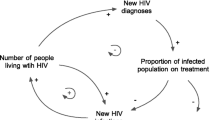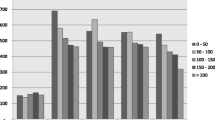Abstract
Objective: The United States Public Health Service (USPHS) published recommendations for human immunodeficiency virus (HIV) postexposure prophylaxis (PEP) of healthcare workers in May 1998. The aim of this study was to analyse the cost effectiveness of the USPHS PEP guidelines.
Design and setting: This was a modelling study in the setting of the US healthcare system in 1998. The analysis was performed from the societal perspective; however, only HIV healthcare costs were considered and health-related losses of productivity were not included.
Methods: A decision tree incorporating a Markov model was created for 4 PEP strategies: the current USPHS recommendations, triple drug therapy, zidovudine monotherapy or no prophylaxis. A probabilistic sensitivity analysis using a Monte Carlo simulation was performed. Confidence intervals (CIs) around cost-effectiveness estimates were estimated by a bootstrapping method.
Results: The costs (in 1997 US dollars) per quality-adjusted life-year (QALY) saved by each strategy were as follows: monotherapy $US688 (95% CI: $US624 to $US750); USPHS recommendations $US5211 (95% CI: $US5126 to $US5293); and triple drug therapy $US8827 (95% CI: $US8715 to $US8940). The marginal cost per year of life saved was: USPHS recommendations $US81 987 (95% CI: $US80 437 to $US83 689); triple drug therapy $US970 451 (95% CI: $US924 786 to $US1 014 429). Sensitivity testing showed that estimates of the probability of seroconversion for each category of exposure were most influential, but did not change the order of strategies in the baseline analysis. With the prolonged HIV stage durations and increased costs associated with recent innovations in HIV therapy, the marginal cost effectiveness of the USPHS PEP strategy was decreased to $US62 497/QALYsaved. All 3 intervention strategies were cost effective compared with no postexposure prophylaxis.
Conclusions: Current USPHS PEP recommendations are marginally cost effective compared with monotherapy, but the additional efficacy of triple drug therapy for all risk categories is rewarded by only a small reduction in HIV infections at great expense. For the foreseeable future, assuming innovations in therapy that employ expensive drug combinations earlier in the HIV disease course to extend life expectancy and the increasing prevalence of HIV drug resistance, our model supports the use of the USPHS PEP guidelines.







Similar content being viewed by others
References
Bell DM. Occupational risk of human immunodeficiency virus infection in health care workers: an overview. Am J Med 1997; 102: 9–15
Centers for Disease Control and Prevention. Update: provisional public health service recommendations for chemoprophylaxis after occupational exposure to HIV. MMWR Morb Mortal Wkly Rep 1996; 45: 468–72
Centers for Disease Control and Prevention. Public health service guidelines for the management of health-care worker exposures to HIV and recommendations for postexposure prophylaxis. MMWR Morb Mortal Wkly Rep 1998; 47: 1–33
Henderson DK, Gerberding JL. Prophylactic zidovudine after occupational exposure to the human immunodeficiency virus: an interim analysis. J Infect Dis 1989; 160: 321–7
Centers for Disease Control and Prevention. Public health service statement on the management of occupational exposure to human immunodeficiency virus, including considerations regarding zidovudine postexposure use. MMWR Morb Mortal Wkly Rep 1990; 39: 1–14
Puro V, Ippolito G, Guzzanti E, et al. Zidovudine prophylaxis after accidental exposure to HIV. The Italian study group on occupational risk of HIV infection. AIDS 1992; 6: 963–9
Tokars JI, Marcus R, Culver DH, et al. Surveillance of HIV infection and zidovudine use among health care workers after occupational exposure to HIV-infected blood. Ann Intern Med 1993; 118: 913–9
Centers for Disease Control and Prevention. Case-control study of HIV seroconversion in health-care workers after percutaneous exposure to HIV-infected blood - France, United Kingdom, and United States, January 1988 – August 1994.MMWR Morb Mortal Wkly Rep 1995; 44: 929–33
Connor EM, Sperling RS, Gelber R, et al. Reduction of maternalinfant transmission of human immunodeficiency virus type 1 with zidovudine treatment. N Engl JMed 1994; 331: 1173–80
Ramsey SD, NettlemanMD. Cost-effectiveness of prophylactic AZT following needle stick injury in health care workers. Med Decis Making 1992; 12: 142–8
Allen UD, Read S, Gafni A. Zidovudine for chemoprophylaxis after occupational exposure to HIV-infected blood: an economic evaluation. Clin Infect Dis 1992; 14: 822–30
Pinkerton SD, Holtgrave DR, Pinkerton HJ. Cost-effectiveness of chemoprophylaxis after occupational exposure to HIV. Arch Intern Med 1997; 157: 1972–80
Scheid DC, Stevens K, Hamm RM. Cost-effectiveness of human immunodeficiency virus post-exposure prophylaxis. Med Decis Making 1997; 17: 525
Gold MR, Siegel JE, Russel LB, et al. Cost-effectiveness in health and medicine. New York: Oxford University Press, 1996
McCray E. Occupational risk of the acquired immunodeficiency syndrome among health care workers. N Engl J Med 1986; 314: 1127–32
Ippolito G, Puro V, De Carli G, et al. The risk of occupational human immunodeficiency virus infection in health careworkers. Arch Intern Med 1993; 153: 1451–8
Cardo DM, Culver DH, Ciesielski CA, et al. A case-control study of HIV seroconversion in health care workers after percutaneous exposure. N Engl J Med 1997; 337: 1485–90
Gerberding JL. Prophylaxis for occupational exposure to HIV. Ann Intern Med 1996; 125: 497–501
Henderson DK. Postexposure chemoprophylaxis for occupational exposure to human immunodeficiency virus type 1: current status and prospects for the future. Am J Med 1991; 91: 312–9
Ippolito G, Puro V, Italian registry of antiviral prophylaxis. Zidovudine toxicity in uninfected healthcare workers. Am J Med 1997; 102: 58–62
Wainberg MA, Friedland G. Public health implications of antiretroviral therapy and HIV drug resistance. JAMA1998; 279: 1977–83
Hirsch MS, Conway B, D’Aquilla RT, International AIDS Society - USA Panel, et al. Antiretroviral drug resistance testing in adults with HIV infection. JAMA 1988; 279: 1984–91
Mayers DL. Prevalence and incidence of resistance to zidovudine and other antiretroviral drugs. Am J Med 1997; 102: 70–5
Frankel LM, Wagner II LE, Demeter LM, et al. Effects of zidovudine use during pregnancy on resistance and vertical transmission of human immunodeficiency virus type I. Clin Infect Dis 1995; 20: 1321–6
Gerberding JL. Postexposure prophylaxis for human immunodeficiency virus at San Francisco General Hospital. Am J Med 1997; 102: 85–9
Fahrner R, Meekman SE, Koziol DE, et al. Safety of zidovudine (ZDV) administered as post-exposure prophylaxis to health care workers (HCW) sustaining HIV-related occupational exposures (OE). In: Program and abstracts — Interscience Conference on Antimicrobial Agents and Chemotherapy: 1994 Oct 4–7; Orlando (FL). Washington, DC: American Society for Microbiology, 1994: 133
Locality fee schedule report. Oklahoma City (OK): Health Care Financing Administration, 1997
Average wholesale price. Indianapolis (IN): Medispan Inc., 1997
Hellinger FJ. The lifetime cost of treating a person with HIV. JAMA 1993; 270: 474–8
Gable CB, Tierce JC, Simison D, et al. Cost of HIV+/AIDS at CD4+ counts disease stages based on treatment protocols. J Acquir Immune Defic Syndr Hum Retrovirol 1996; 12: 413–20
Hurley SF, Kaldor JM, Gardiner S, et al. Lifetime cost of human immunodeficiency virus-related health care. J Acquir Immune Defic Syndr Hum Retrovirol 1996; 12: 371–8
Longini IMJ, Clark WS, Karon JM. Effect of routine use of therapy in slowing the course of human immunodeficiency virus (HIV) infection in a population-based cohort. Am J Epidemiol 1993; 137: 1229–40
CAESAR Group. Randomized trial of addition of lamivudine or lamivudine plus loviride to zidovudine-containing regimens for patients with HIV-1 infection: the CAESAR trial. Lancet 1997; 349: 1413–4
Owens DK, Nease RFJ. Transmission of HIV infection between provider and patient: quantitative analysis of risk. In: Kaplan EH, Brandeau ML, editors. Modeling the AIDS epidemic: planning, policy, and prediction. New York (NY): Raven Press, 1994: 153–77
Holtgrave DR, Pinkerton SD. Updates of cost of illness and quality of life estimates for use in economic evaluations of HIV prevention programs. J Acquir Immune Defic Syndr Hum Retrovirol 1996; 12: 413–20
Consumer Price Index - all urban consumers, medical services. Series ID: CUUR0000SAM. Washington, DC: US Bureau of Labor Statistics [online]. Available from: URL: www.146.142.4.24 [Accessed 2000 Aug 14]
Beck JR, Pauker SG. The Markov process in medical prognosis. Med Decis Making 1983; 3: 419–58
Sonnenberg FA, Beck JR. Markov models in medical decision making: a practical guide. Med Decis Making 1993; 13: 322–38
Fryback DG, Dasbach EJ, Klein R, et al. The Beaver Dam Health Outcomes Study: initial catalog of health-state quality factors. Med Decis Making 1993; 13: 89–102
National Center for Health Statistics. U.S. decennial life tables for 1989–1991. Hyattsville (MD): National Center for Health Statistics, 1997
Doubilet P, Begg CB, Weinstein MC, et al. Probabilistic sensitivity analysis using Monte Carlo simulation: a practical approach. Med Decis Making 1985; 5: 157–77
Hunink MGM, Bult JR, De Vries J, et al. Uncertainty in decision models analyzing cost-effectiveness: the joint distribution of incremental costs and effectiveness evaluated with a nonparametric bootstrap method. Med Decis Making 1998; 18: 337–48
Efron B, Tibshirani RJ. An introduction to the bootstrap. New York (NY): Chapman and Hall, 1993
Laupacis A, Feeney D, Detsey AS, et al. How attractive does a new technology have to be to warrant adoption and utilization? Tentative guidelines for using clinical and economic evaluations. Can Med Assoc J 1992; 146: 473–80
Hammer SM, Squires KE, Hughes MD, et al. A controlled trial of two nucleoside analogues plus indinavir in persons with human immunodeficiency virus infection and CD4 cell counts of 200 per cubic millimeter or less. N Engl J Med 1997; 337: 725–33
Palella FJ, Delaney KM, Moorman AC, et al. Declining morbidity and mortality among patients with advanced human immunodeficiency virus infection. N Engl J Med 1998; 338: 853–60
Author information
Authors and Affiliations
Corresponding author
Rights and permissions
About this article
Cite this article
Scheid, D.C., Hamm, R.M. & Stevens, K.W. Cost Effectiveness of Human Immunodeficiency Virus Postexposure Prophylaxis for Healthcare Workers. Pharmacoeconomics 18, 355–368 (2000). https://doi.org/10.2165/00019053-200018040-00004
Published:
Issue Date:
DOI: https://doi.org/10.2165/00019053-200018040-00004




